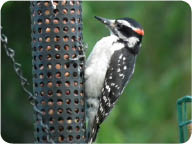 Hairy Woodpecker
Hairy Woodpecker
Picoides villosus
Description
The Hairy Woodpecker is a medium-sized woodpecker with a long, straight bill (which is at least as long as its head) and long tail feathers. Its back is black with a white stripe down the middle. The wings are black with white bars. Its head is black with white stripes; adult males have a red patch at the back of the head. The Hairy Woodpecker is very similar in appearance to the Downy Woodpecker. The Downy Woodpecker is shorter with a smaller bill and barred outer tail feathers.
Size
Hairy Woodpeckers measure 9-13 inches (23-33 cm) long (about the size of a robin) and weigh 1.5-3.5 ounces (43-99 g).
Adaptations
- Woodpeckers have special feet, with two toes pointing forward and two toes pointing backward, which help them to grip the side of a tree.
- The strong head and neck muscles of woodpeckers enable them to peck at the side of a tree without injuring themselves. The tuft of feathers covering the nostrils keeps out dust and splinters formed by pecking at wood.
- The long, narrow shape of a woodpecker’s beak is perfect for drilling into trees and excavating insects.
- The Hairy Woodpecker’s long, rigid tail feathers help to support the bird as it climbs up the trunks of trees.
Diet
Hairy Woodpeckers eat primarily insects. They will also eat spiders and occasionally, seeds, nuts and fruits. Hairy Woodpeckers are often seen eating suet from backyard bird feeders.
Reproduction
Hairy Woodpeckers breed between February and June. Females advertise that they are ready to breed by drumming on the side of a tree with their beaks. Males create the nests by hollowing out part of a dead tree branch or trunk. Females lay 2-5 white eggs per clutch (group of eggs). Incubation of the eggs is done by both parents and takes approximately 14 days. After 28-30 days, the young birds leave the nest. Hairy Woodpeckers raise one clutch per year.
Shelter and Space Needs
Hairy Woodpeckers are found in forests and on forest edges. They require large trees in their habitats to serve as nesting locations and in which they forage for food. These birds are found throughout North America.
Life Expectancy
The life expectancy for this species is uncertain. In captivity, some Hairy Woodpeckers have lived to be more than 15 years old, although the average lifespan for a wild bird is most certainly much shorter than that.
Importance to Man
Hairy Woodpeckers eat the insects that destroy forest trees, thereby saving the trees. They also play an important role in the ecosystem as a food source for many predators, such as hawks and owls.
Fun Facts
- Woodpeckers are able to hammer into wood at the rate of 100 blows per minute!
- Have you ever wondered why woodpeckers don’t get a headache from all that pounding? Their skulls are similar to football helmets, with thick bones and cartilage that acts as a shock absorber by filling the extra space in the skull and keeping the brain from moving around inside.
- A woodpecker’s tongue has to be very long to probe trees for insects. Its tongue is at least twice the length of its bill!





